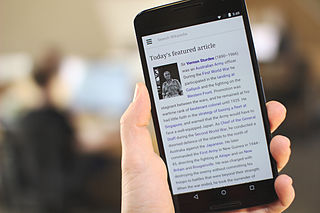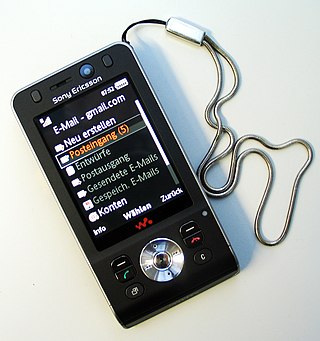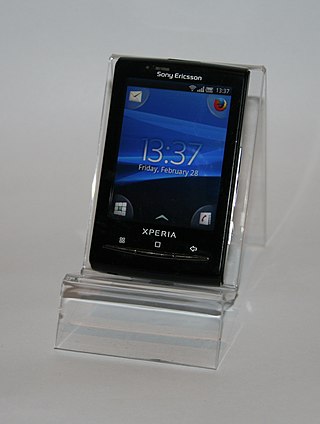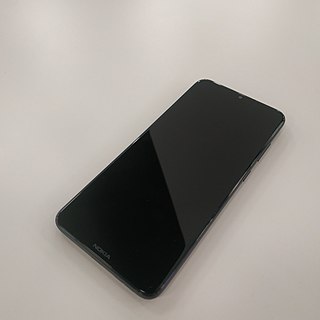
A smartphone, often called simply a phone, is a mobile device that combines the functionality of a traditional mobile phone with advanced computing capabilities. It typically has a touchscreen interface, allowing users to access a wide range of applications and services, such as web browsing, email, and social media, as well as multimedia playback and streaming. Smartphones have built-in cameras, GPS navigation, and support for various communication methods, including voice calls, text messaging, and internet-based messaging apps.
Sony Mobile Communications Inc. was a multinational telecommunications company founded on October 1, 2001, as a joint venture between Sony Corporation and Ericsson. It was originally incorporated as Sony Ericsson Mobile Communications, and headquartered in London, England, until Sony acquired Ericsson's share in the venture on February 16, 2012. On April 1, 2021, Sony integrated its electronics businesses including Sony Mobile into one company called Sony Corporation.

The Sony Ericsson K800i, and its variant, the Sony Ericsson K790, are mobile phone handsets manufactured by Sony Ericsson. Launched in July 2006, the phones are the successor to the Sony Ericsson K750i, and are the first to be tagged with the Cyber-shot branding. Both of the phones feature a 3.2-megapixel digital camera complete with a xenon flash, a protective lens cover, and a new "BestPic" bracketing feature. The new "BestPic" feature takes 9 full quality snapshots of a subject in quick succession, allowing the user to choose the best shots from them. On the entertainment front, the phones have a media player supporting MP3, AAC/AAC+/eAAC+ and WMA music files and 3GP/MPEG-4 video files. The phones also feature a RDS FM radio, and a Memory Stick Micro (M2) slot for expandable solid state memory. The K790/K800 models are also the first Sony Ericsson mobile phones to use ATI's Imageon 2192 graphics engine, which delivers a full 3D gaming graphics for Java and full support for its 3.2-megapixel camera. It is the phone used by James Bond in the 2006 Casino Royale film and trailers.

The Nokia 3110 classic is a mobile phone handset, manufactured by Nokia in Hungary and released for sale in 2007. It is a budget model with similar features to the Nokia 6300. Although the phone bears the same model number as the 1997 Nokia 3110, it was not directly derived from this model.

The Sony Ericsson W910i is a slider model music phone. The W910i was announced on June 14, 2007, as a branded "Walkman phone" and uses version 3 of the 'Walkman Player'. The phone also features the shake control feature found on the W580 that enables music track switching by shaking the phone and also for Java ME based video games and applications using the JP-8.

The Sony Ericsson S500i is a mobile phone manufactured by Sony Ericsson. The phone was announced in May 2007 and released in the 3rd quarter of 2007.

Sustainable packaging is packaging materials and methods that result in improved sustainability. This involves increased use of life cycle inventory (LCI) and life cycle assessment (LCA) to help guide the use of packaging which reduces the environmental impact and ecological footprint. It includes a look at the whole of the supply chain: from basic function, to marketing, and then through to end of life (LCA) and rebirth. Additionally, an eco-cost to value ratio can be useful The goals are to improve the long term viability and quality of life for humans and the longevity of natural ecosystems. Sustainable packaging must meet the functional and economic needs of the present without compromising the ability of future generations to meet their own needs. Sustainability is not necessarily an end state but is a continuing process of improvement.

The Sony Ericsson K600 is a 3G mobile phone handset manufactured by Sony Ericsson. It was announced in the first quarter of 2005.

The Sony Ericsson W995 is a candybar slider model music phone designed by Sony Ericsson as the new Walkman flagship phone, previously known as codename "Hikaru". The W995 was introduced February 2009 and released on 4 June 2009 and uses the 4th version of the 'Walkman Player'. It is also the first Walkman phone to feature a standard 3.5 mm headset jack rather than requiring a FastPort connection. It features an 8.1-megapixel camera which seems similar to the C905. Although its camera is comparable to other cameraphones, the video quality is only QVGA (320×240) at its maximum, unlike the majority of cameraphones at the time that had VGA and HD videos.

The Sony Ericsson Vivaz (U5i) is a smartphone, announced by Sony Ericsson on 21 January 2010. It was released on 5 March 2010 in the color schemes Moon Silver, Cosmic Black, Galaxy Blue and Venus Ruby.

The Sony Ericsson Xperia X10 Mini—also known as the E10i (international) or E10a (Americas)—is a smartphone by Sony Ericsson in the Xperia series. It is the second Sony Ericsson smartphone to run the Android operating system, and at the time was the smallest Android handset ever made.

The Sony Ericsson Xperia mini is an Android smartphone from Sony Ericsson, released in August 2011. The Xperia mini has a "mobile BRAVIA engine" driving a 320×480 pixels 3-inch (76 mm) capacitive touch-screen, a 1 GHz Snapdragon S2 processor, a 5 megapixel camera, 512 MB of onboard RAM, and comes stock with a 2 GB microSD card. The phone is one of Sony Ericsson's environmentally friendly "Greenheart" range, featuring devices made of recycled materials, longer battery life and low-energy chargers, as well as minimal use of paper through reduced packaging and the replacement of the traditional printed user manual with one stored on the phone.

The Sony Ericsson Xperia ray (ST18i) is an Android smartphone from Sony Ericsson. It was unveiled on 22 June 2011 in Singapore during CommunicAsia 2011. It was announced that the Xperia ray would be released globally in select countries from Q3 2011.

The Sony Xperia V is a smartphone designed, developed and marketed by Sony Mobile. Presented initially on 29 August 2012 in Berlin, the Xperia V was released in December 2012 and belongs to Sony's handset line up of the second half of 2012, which includes the flagship Xperia T and the entry-level Xperia J. The 4.3-inch (110 mm) device employs a 1280×720 (720p) pixel resolution display, a 1.5 GHz dual-core processor and a 13-megapixel camera, and an interchangeable battery while protected by a water-resistant outer skin. This is the first Sony Mobile's device alongside the Xperia J that does not feature the Sony Ericsson's liquid energy logo.

The Sony Ericsson Cedar (j108i), also known as Sony Ericsson Cedar GreenHeart, is a mobile phone from SE's J series of phones produced by Sony Ericsson released in September 2010. It is the last Sony Ericsson phone that run on proprietary Sony Ericsson A2 Operating System as Greenheart switched to the Sony Xperia line of Android Smartphones. The phone is one of Sony Ericsson's environmentally friendly "Greenheart" range, featuring devices made of recycled materials, longer battery life and low-energy chargers, as well as minimal use of paper through reduced packaging and the replacement of the traditional printed user manual with one stored on the phone. This device also the first cell phone from Sony Ericsson to fully abandon Sony's Proprietary Charger and Memory Card Format, The Memory Stick Pro Duo used in older models and Memory Stick Micro (M2) used in more newer feature models by using standard Micro USB for Charging and Data Transfer and Micro SD Format for expandability, adding the standard 3.5mm headphone jack on the top.

The Sony Xperia Z3 Compact is an Android smartphone produced by Sony. As part of the Z Series, the Z3 Compact was unveiled during a press conference in IFA 2014 on 4 September 2014 and belongs to Sony's handset lineup of the second half of 2014, which includes the flagship Xperia Z3 and the entry-level Xperia C3. Like the preceding Z1 Compact, the Z3 Compact is water-proof with an IP rating of IP65 and IP68. The phone features a new display, a Qualcomm Snapdragon 801 processor, and has the ability to record 4K videos.
The Sony Xperia M5 is a water & dust resistant high-range Android smartphone manufactured by Sony serving as the successor to the Xperia M4 Aqua. The phone was unveiled on 3 August 2015 along with the Xperia C5 Ultra. The phone is marketed as a “super mid-range” phone, which is between its predecessor, the M4 Aqua, and the flagship, the Xperia Z5

The OnePlus 5 is a smartphone made by OnePlus. It is the successor to the OnePlus 3T, which was released in 2016. The OnePlus 5 was officially unveiled during a keynote on 20 June 2017 and first released on June 20, 2017. It was succeeded by the OnePlus 5T five months later on November 21, 2017.

The Nokia 5.3 is a Nokia-branded mid-range smartphone by HMD Global, running Android One. It was announced on March 19, 2020, alongside the Nokia 8.3 5G, Nokia 1.3 and Nokia 5310 (2020).

















